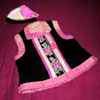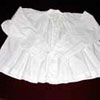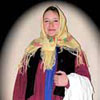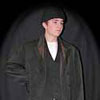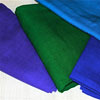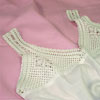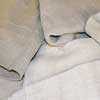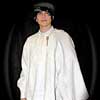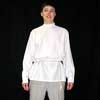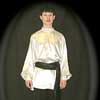Fashion Part 1 Fashion Part 2 Fashion Part 3
Heritage Fashions and Fabrics
Doukhobor immigrants arrived in Canada in 1899 in the ancestral heritage fashion consisting of colorful, yet warm and practical clothing. The women dressed in black, decorated vests, the gathered long woolen skirts and “zanaveski” (aprons), the white cotton or brightly colored woolen blouses and hand made hats with a large flower on the front, often worn under woolen shawls. (image01 and image 02) The men were attired in dark, warm, woolen clothing, trousers and jackets or knee length coats with a sash at the waist. These garments were either hand made traditional Russian peasant clothing or professionally tailored in Russia, as both were brought to Canada and worn during the early pioneer years. They wore high boots and round hats made from either fur or sheepskin.
This trend continued into the early years of settlement on the Canadian prairies where sheep were plentiful to produce the woolen yarn. Dark colors such as purple, black, green and blue, as well as red and bright pink, were used to dye this durable woven cloth which was then sewn into the traditional clothing. (image03) Packaged commercial dyes were used to dye the yarn for knitting but often woven fabric was dyed as it was required. A skirt length would be cut off the woven yardage, the skirt partly made up and then dyed. The best and firmest twill, dyed black, was tailored for the Doukhobor leaders and other dignitaries. (image04) The Doukhobors had an affinity for the ethnic costume and the household items that they brought from their homeland. By wearing the traditional costumes they felt connected to the country they left behind. Later, when money became available to purchase store bought fabrics, children were dressed in cottons and hand knitted sweaters and stockings. The softest wool fleece was set aside for spinning yarn for socks, stockings, caps and fine crochet edgings on bed linens. (image05)
The undergarments for both males and females were sewn from bleached flour or sugar sacks. The yoke of the female “leefchik” or undershirt was crocheted in a fancy pattern. (image06) Many pieces of clothing and household items such as aprons, tablecloths and dishtowels were sewn from the flour sacks and were decorated with hand embroidery and lacy edgings.
Linen fabric became the textile of choice for summer clothing when the Doukhobors migrated to British Columbia in 1908. Because they lived near rivers where the soil was moist, they were able to prepare linen. For the winter, they still used wool that was sent from Saskatchewan. Flax was planted, threshed and spun into linen and woven into fabric lengths for sewing. (image07 and image08) There were variations in the color of linen fibres dependent on where the flax was grown and how it was prepared. The weaving patterns varied as a result of the choice and skill of the weaver in each community. Linen fabric was sewn into women’s and men’s suits, but later the primary use was for sewing the “kasavarotka,” a traditional shirt, worn by the men.
Hand woven fabric was used by our grandmothers, the first generation Canadians, and as time passed, the Doukhobors became more integrated into the Canadian society and the old ways slowly started disappearing. The skill of spinning and weaving was pursued by only a few. Most Doukhobor women sewed everyday clothing for their family and some, who developed the required skill, provided tailoring services for the community. (image09 and image10)
The “kasavarotka” is still worn by men on special occasions, but the material used now for the traditional kasavarotka is a “linen look-a-like,” a polyester in a natural or colored fabric. (image11 and image 12)
Back to previous page To Next Page in this Section

